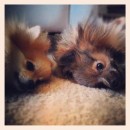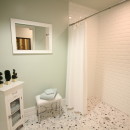OCD & Pets: Sexual Thoughts & Scrupulosity
Obsessions focusing on pets and animals incorporate all the common themes: contamination, checking, harm, scrupulosity, and sex. In this 3-part blog series, I’ll discuss some of the common ways obsessions may target our lovable, snuggable friends. Part 1 focused on harm obsessions, including the fear of accidental and intentional harm, and Part 2 covered contamination obsessions. This final part, Part 3, will address sexual obsessions and scrupulosity, as they pertain to pets. Our animals are members of our family. We treat them as our own. It’s not surprising, then, that OCD extends unwanted thoughts to our furry, fluffy companions. OCD loves to attach taboo thoughts to things we love, and our pets are no exception. Just as many parents struggle with obsessions that target their children (e.g., What if I secretly want to harm my child?; What if I...
Read MoreContamination OCD – Long Shower Exposures
Long shower times? Just a quick announcement… I’m pleased to announce that with our recent office renovations, we now have a spa-like therapeutic shower room that is perfect for individuals with contamination OCD who have excessively long shower times. This room is ideal for those with contamination OCD who wish to work on shower-based response prevention. For individuals with contamination OCD who take really long showers, we are now able to provide office-based interventions for reducing your long shower times. We’ve had great success with reducing our patients long shower times from multiple hours to a mere 10-15 minutes. Reduce Long Shower Times to Short OCD Shower Times We do this first by developing shower-based response prevention guidelines and modeling non-OCD based shower behavior in-session. We essentially use a shower script to help individuals identify normal shower routines (which,...
Read MoreImaginal Exposure vs. In Vivo Exposure for OCD
As I’ve talked about in numerous posts, overcoming OCD involves learning to co-exist with doubt and uncertainty. This idea can be a bit counter-intuitive at first, as many people initially expect OCD treatment to reduce uncertainty. One therapeutic approach that helps with this process is exposure and response prevention (ERP) for OCD. Not surprisingly, ERP consists of two parts: 1) exposure, and 2) response prevention. An exposure is when you do something on purpose to provoke an anxiety spike. By definition, exposures are not accidental; rather, they are pre-planned, deliberate offensive strikes against your OCD. Exposures are designed to help you build up your tolerance to fear-producing situations. Exposures are often completed according to an exposure hierarchy, meaning that people typically complete lower level exposures (i.e., less distressing exposures) before gradually working up to higher level ones. Response prevention...
Read MoreOCD Treatment Group Using ERP
OCD Treatment Group! I am pleased to announce the availability of our new exposure and response prevention (ERP)-based treatment group. The intent of this group is to provide a supportive environment for completing ERPs. Participants wishing to attend are required to register using the links at the bottom of this post. This group will first meet on Saturday (8/10/13), 1pm-3pm. The fees for attending this group are $75/session or $50/session if you pay in advance and commit to a 4-week group treatment sequence. Insurance will not be accepted; however, if you have out-of-network benefits, you may be eligible to submit your bill for reimbursement by your insurance company. Subsequent 2-hour sessions will be held on 8/17, 8/24, and 8/31 @ 1pm. You are free to participate in any or all of these sessions; however, individuals are most likely to...
Read MoreOCD & Checking: Part 2 (Mental Checking)
Behavioral Checking (Overt Checking) Many examples of compulsive checking rituals in OCD involve direct inspection of a target stimulus by sight, sound, or feel. Common OCD checking behaviors include relocking doors, visually examining the position of one’s parking brake, or holding one’s hands above stove burners in order to detect warmth. Behavioral checking is often accompanied by the thought, “Did I do it the right way?” These checking behaviors are often referred to as behavioral checks, manual checks, or overt checks. Overt rituals (by definition) are visible behaviors that can be perceived by external observers. However, in some cases, overt rituals may be subtle or purposefully hidden in order to avoid embarrassment. Mental Checking (Covert Checking) In contrast, other compulsive checking rituals can only be perceived by the individual engaging in the behavior. These types of OCD rituals are...
Read More







